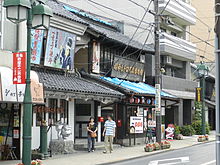Fujio Akatsuka
Fujio Akatsuka ( Japanese 赤 塚 不二 夫 , Akatsuka Fujio , really 赤 塚 藤 雄 at the same reading; born September 14, 1935 in Manchukuo (today: People's Republic of China ); † August 2, 2008 in Tokyo ) was a Japanese manga artist . He was one of the most important representatives of the gag manga and contributed significantly to its success.
biography
Akatsuka was born the son of an officer in the military police in the Japanese-occupied Manchuria ( Manchukuo ). During his childhood, his mother entrusted him to relatives because of her poverty.

In the 1950s he worked in a Tokyo chemical plant and drew comics in his spare time, which he sent to the manga magazine Manga Shōnen , which at the time offered a platform for young manga artists. Together with Shōtarō Ishinomori , Hideko Mizuno and others, he lived in the Tokiwasō community , which was a meeting place for the students of Osamu Tezuka . Akatsuka began his career as a cartoonist at lending libraries ( Kashihonya ), where he published his first manga in 1956 under the title Arashi o koete . These first works were designed for young girls. Although he was not comfortable in this genre, he continued to create shōjo manga for a few years .
The illustrator had his breakthrough in 1962 with Osomatsu-kun , who appeared in Shōnen Sunday . This and numerous subsequent gag manga, which were created under the influence of American films by Charlie Chaplin , for example , were characterized by a disrespectful, anarchist comedy whose taboos in the 1960s paved the way for later cartoonists, who in their mangas for young people had sex and violence brought in. In addition to Osomatsu-kun , Tensai Bakabon , on whom he worked for various magazines from 1967, became known. This work is about an idiotic father-son couple. 1970 Nyarome, a minor character from his gag manga Mōretsu Atarō , became popular with members of the activist student organization Zengakuren . Akatsuka's assistants such as Kazuyoshi Torii and Mitsutoshi Furuya also became successful gag mangaka.
Also in 1962, he began a successful teenage girl manga series in Ribon magazine, Himitsu no Akko-chan . This was one of the first magical girl mangas. In the manga, the fifth grader Akko is given magical powers by the Queen of Mirror Land. Himitsu no Akko-chan , like several other works by Akatsuka, was implemented several times as an anime television series.
Akatsuka also worked as a writer and film producer over the years and, with his company, Fujio Productions, promoted gag artists. Since 1974 Shūeisha has been awarding the Akatsuka Prize to young comic artists in the gag-manga area every six months .
From April 2002 he suffered from intracerebral haemorrhage . In 2008, at the age of 72, he died of pneumonia in a Tokyo hospital.
Awards
- 1965: Shogakukan Manga Prize for Osomatsu-kun
- 1971: Bungei Shunjū Manga Prize for Tensai Bakabon
- 1997: Lifetime Achievement Award from the Association of Japanese Cartoonists
Works (selection)
- Arashi o koete ( 嵐 を こ え て ), 1956
- Osomatsu-kun (お そ 松 く ん ), 1962-1969, 1972-1973, 1987-1990
- Himitsu no Akko-chan (ひ み つ の ア ッ コ ち ゃ ん ), 1962–1965, 1968–1969, 1988–1989
- Tensai Bakabon (天才 バ カ ボ ン ), 1967–1978, 1987–1992
- Mōretsu Atarō ( も ー れ つ ア 太郎 ), 1967-1970, 1990-1991
- Rettsu Ragon ( レ ッ ツ ラ ゴ ン ), 1971–1974
- Gag Guerilla ( ギ ャ グ ゲ リ ラ ), 1972–1982
Web links
- Fujio Akatsuka in the Internet Movie Database (English)
- Official Website (Japanese)
Individual evidence
- ↑ a b c d Frederik L. Schodt: Manga! Manga! The World of Japanese Comics . Kodansha America, 1983, ISBN 0-870-11752-1 , pp. 120ff.
- ↑ a b Jaqueline Berndt : Manga phenomenon . edition q, Berlin 1995, ISBN 3-86124-289-3 , p. 181.
- ↑ a b 漫画家 赤 塚 不二 夫 さ ん 死去 . Yomiuri Shimbun , August 2, 2008, archived from the original on August 18, 2008 ; Retrieved June 24, 2011 (Japanese).
- ↑ Masanao Amano: Manga Design . Taschen Verlag, Cologne 2004, ISBN 3-8228-2591-3 , p. 30.
| personal data | |
|---|---|
| SURNAME | Akatsuka, Fujio |
| ALTERNATIVE NAMES | 赤 塚 不二 夫 (Japanese, pseudonym); 赤 塚 藤 雄 (Japanese) |
| BRIEF DESCRIPTION | Japanese manga artist |
| DATE OF BIRTH | September 14, 1935 |
| PLACE OF BIRTH | Manchukuo (today: People's Republic of China ) |
| DATE OF DEATH | August 2, 2008 |
| Place of death | Tokyo |